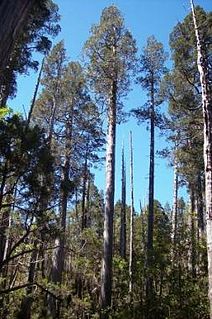
Kiwi are flightless birds endemic to New Zealand of the genus Apteryx and family Apterygidae. Approximately the size of a domestic chicken, kiwi are by far the smallest living ratites.

Penguins are a group of aquatic flightless birds. They live almost exclusively in the southern hemisphere: only one species, the Galápagos penguin, is found north of the Equator. Highly adapted for life in the water, penguins have countershaded dark and white plumage and flippers for swimming. Most penguins feed on krill, fish, squid and other forms of sea life which they catch while swimming underwater. They spend roughly half of their lives on land and the other half in the sea.

Moa were nine species of now-extinct flightless birds endemic to New Zealand. The two largest species, Dinornis robustus and Dinornis novaezelandiae, reached about 3.6 m (12 ft) in height with neck outstretched, and weighed about 230 kg (510 lb) while the smallest, the bush moa, was around the size of a turkey. Estimates of the Moa population when Polynesians settled New Zealand circa 1300 vary between 58,000 and approximately 2.5 million.

The kākāpō, also known as the owl parrot, is a species of large, flightless, nocturnal, ground-dwelling parrot of the super-family Strigopoidea, endemic to New Zealand.

Nothofagus, also known as the southern beeches, is a genus of 43 species of trees and shrubs native to the Southern Hemisphere in southern South America and Australasia. The species are ecological dominants in many temperate forests in these regions. Some species are reportedly naturalised in Germany and Great Britain. The genus has a rich fossil record of leaves, cupules, and pollen, with fossils extending into the late Cretaceous period and occurring in Australia, New Zealand, Antarctica, and South America.

The New Zealand sea lion, also known as Hooker's sea lion, and as whakahao or rāpoka in Māori, is a species of sea lion that is endemic to New Zealand and primarily breeds on New Zealand's subantarctic Auckland and Campbell islands, and have in recent years been slowly breeding and recolonising around the coast of New Zealand's South and Stewart islands. The New Zealand sea lion numbers around 12,000 and is one of the world's rarest sea lion species. They are the only species of the genus Phocarctos.

The conservation status of a group of organisms indicates whether the group still exists and how likely the group is to become extinct in the near future. Many factors are taken into account when assessing conservation status: not simply the number of individuals remaining, but the overall increase or decrease in the population over time, breeding success rates, and known threats. Various systems of conservation status exist and are in use at international, multi-country, national and local levels as well as for consumer use.
Hyposmocoma molluscivora is a Hawaiian moth whose larvae are predators, capturing snails in their silk, much like a hunting spider's web, and then crawling inside the snail's shell to eat it alive. It has been called the snail-eating caterpillar or the flesh-eating caterpillar, though no common name has been widely prescribed to it.

New Zealand is an island country in the southwestern Pacific Ocean. It consists of two main landmasses—the North Island and the South Island —and over 700 smaller islands, covering a total area of 268,021 square kilometres (103,500 sq mi). New Zealand is about 2,000 kilometres (1,200 mi) east of Australia across the Tasman Sea and 1,000 kilometres (600 mi) south of the islands of New Caledonia, Fiji, and Tonga. The country's varied topography and sharp mountain peaks, including the Southern Alps, owe much to tectonic uplift and volcanic eruptions. New Zealand's capital city is Wellington, and its most populous city is Auckland.
Arthur William Baden Powell was a New Zealand malacologist, naturalist and palaeontologist, a major influence in the study and classification of New Zealand molluscs through much of the 20th century. He was known to his friends and family by his third name, "Baden".
Tornatellides is a genus of minute, air-breathing land snails, terrestrial gastropod mollusks, or micromolluscs in the family Achatinellidae.

Achatinellidae is a family of tropical air-breathing land snails, terrestrial pulmonate gastropod mollusks in the superfamily Pupilloidea.

The Antarctic Floristic Kingdom, also the Holantarctic Kingdom, is a floristic kingdom that includes most areas of the world south of 40°S latitude. It was first identified by botanist Ronald Good, and later by Armen Takhtajan. The Antarctic Floristic Kingdom is a classification in phytogeography, different from the Antarctic realm classification in biogeography, and from Antarctic flora genera/species classifications in botany.

The New Zealand Threat Classification System is used by the Department of Conservation to assess conservation priorities of species in New Zealand.
The New Zealand Plant Conservation Network (NZPCN) is a non-governmental organisation devoted to the protection and restoration of New Zealand's indigenous plant life, including vascular plants, mosses, liverworts, hornworts and lichens.
Banksia novae-zelandiae is an extinct species of Banksia, known only from fossil leaves found in the South Island of New Zealand.
Hyposmocoma carnivora is a species of moth of the family Cosmopterigidae. It is endemic to Hawaii.
Hyposmocoma pupumoehewa is a species of moth of the family Cosmopterigidae. It is endemic to Maui.

Tornatellides lordhowensis, also known as the Lord Howe miniature treesnail, is a species of tree snail that is endemic to Australia's Lord Howe Island in the Tasman Sea.











